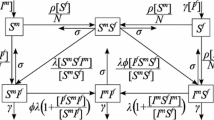Abstract
The combination of long-term concurrent sexual partnerships and high infectiousness early in HIV infection has been suggested as a key driver of the extensive spread of HIV in general populations in sub-Saharan Africa, but this has never been scientifically investigated. We use a mathematical model to simulate HIV spreading on sexual networks with different amounts of concurrency. The models show that if HIV infectiousness is constant over the duration of infection, the amount of concurrency has much less influence on HIV spread compared to when infectiousness varies over three stages of infection with high infectiousness in the first months. The proportion of transmissions during primary infection is sensitive to the amount of concurrency and, in this model, is estimated to be between 16 and 28% in spreading epidemics with increasing concurrency. The sensitivity of epidemic spread to the amount of concurrency is greater than predicted by models that do not include primary HIV infection.



Similar content being viewed by others
References
Hudson CP. Concurrent partnerships could cause AIDS epidemics. Int J STD AIDS. 1993;4:249–53.
Halperin DT, Epstein H. Concurrent sexual partnerships help to explain Africa’s high HIV prevalence: implications for prevention. Lancet. 2004;364:4–6.
Mah TL, Halperin DT. Concurrent sexual partnerships and the HIV epidemics in Africa: evidence to move forward. AIDS Behav. 2010;14:11–6.
Watts CH, May RM. The influence of concurrent partnerships on the dynamics of HIV/AIDS. Math Biosci. 1992;108:89–104.
Morris M, Kretzschmar M. Concurrent partnerships and the spread of HIV. AIDS. 1997;11:641–8.
Morris M, Kretzschmar M. A microsimulation study of the effect of concurrent partnerships on the spread of HIV in Uganda. Math Popul Stud. 2000;8:109–33.
Morris M. Concurrent partnerships and syphilis persistence: new thoughts on an old puzzle. Sex Transm Dis. 2001;28:504–7.
Morris M. Barking up the wrong evidence tree. Comment on Lurie & Rosenthal, Concurrent partnerships as a driver of the HIV epidemic in sub-Saharan Africa? The evidence is limited. AIDS Behav. 2010;14:31–3.
Powers KA, Poole C, Pettifor AE, Cohen MS. Rethinking the heterosexual infectivity of HIV-1: a systematic review and meta-analysis. Lancet Infect Dis. 2008;8:553–63.
Boily MC, Baggaley RF, Wang L, et al. Heterosexual risk of HIV-1 infection per sexual act: systematic review and meta-analysis of observational studies. Lancet Infect Dis. 2009;9:118–29.
Lurie MN, Rosenthal S. Concurrent partnerships as a driver of the HIV epidemic in Sub-Saharan Africa? The evidence is limited. AIDS Behav. 2009;14:17–24.
Shelton JD. Why multiple sexual partners? Lancet. 2009;374:367–9.
Garnett GP, Johnson AM. Coining a new term in epidemiology: concurrency and HIV. AIDS. 1997;11:681–3.
Wawer MJ, Gray RH, Sewankambo NK, et al. Rates of HIV-1 transmission per coital act, by stage of HIV-1 infection, in Rakai, Uganda. J Infect Dis. 2005;191:1403–9.
Shelton JD. A tale of two-component generalised HIV epidemics. Lancet. 2010;375:964–6.
Epstein H. The mathematics of concurrent partnerships and HIV: a commentary on Lurie and Rosenthal, 2009. AIDS Behav. 2010;14:17–24.
Pilcher CD, Tien HC, Eron JJ, et al. Brief but efficient: acute HIV infection and the sexual transmission of HIV. J Infect Dis. 2004;189:1785–92.
Pinkerton SD. Probability of HIV transmission during acute infection in Rakai, Uganda. AIDS Behav. 2008;12:677–84.
Hollingsworth TD, Anderson RM, Fraser C. HIV-1 transmission, by stage of infection. J Infect Dis. 2008;198:687–93.
Hayes RJ, White RG. Amplified HIV transmission during early-stage infection. J Infect Dis. 2006;193:604–5.
Koopman JS, Jacquez JA, Welch GW, et al. The role of early HIV infection in the spread of HIV through populations. J Acquir Immune Defic Syndr Hum Retrovirol. 1997;14:249–58.
Abu-Raddad LJ, Longini IM. No HIV stage is dominant in driving the HIV epidemic in sub-Saharan Africa. AIDS. 2008;22:1055–61.
Xiridou M, Geskus R, de Wit J, Coutinho R, Kretzschmar M. Primary HIV infection as source of HIV transmission within steady and casual partnerships among homosexual men. AIDS. 2004;18:1311–20.
Morris M, Kretzschmar M. Concurrent partnerships and transmission dynamics in networks. Social Netw. 1995;17:299–318.
Kretzschmar M, Morris M. Measures of concurrency in networks and the spread of infectious disease. Math Biosci. 1996;133:165–95.
UNAIDS Reference Group On Estimates Modelling And Projections: Working Group On Measuring Concurrent Sexual Partnerships. HIV: consensus indicators are needed for concurrency. Lancet. 2010;375:621–2.
Gregson S, Garnett GP, Nyamukapa CA, et al. HIV decline associated with behavior change in eastern Zimbabwe. Science. 2006;311:664–6.
Gourvenec D, Taruberekera N, Mochaka O, Kasper T. Multiple concurrent partnerships among men and women aged 15–34 in Botswana: Baseline Study, December 2007, PSI Botswana 2007. http://www.gov.bw/Global/NACAMinistry/PSIBotswana.pdf. Accessed 09 Feb 2010.
Gregson S, Nyamukapa C, Garnett GP, et al. Sexual mixing patterns and sex-differentials in teenage exposure to HIV infection in rural Zimbabwe. Lancet. 2002;359:1896–1903.
Kretzschmar M, Dietz K. The effect of pair formation and variable infectivity on the spread of an infection without recovery. Math Biosci. 1998;148:83–113.
Dietz K, Heesterbeek JA, Tudor DW. The basic reproduction ratio for sexually transmitted diseases. Part 2. Effects of variable HIV infectivity. Math Biosci. 1993;117:35–47.
Garnett GP, Anderson RM. Factors controlling the spread of HIV in heterosexual communities in developing countries: patterns of mixing between different age and sexual activity classes. Philos Trans R Soc Lond B Biol Sci. 1993;342:137–59.
Robinson N, Mulder D, Auvert B, Hayes R. Proportion of HIV infections attributable to other sexually transmitted diseases in a rural Ugandan population: simulation model estimates. Int J Epidemiol. 1997;26:180–189.
Granich RM, Gilks CF, Dye C, De Cock KM, Williams BG. Universal voluntary HIV testing with immediate antiretroviral therapy as a strategy for elimination of HIV transmission: a mathematical model. Lancet. 2009;373:48–57.
Fiscus SA, Pilcher CD, Miller WC, et al. Rapid, real-time detection of acute HIV infection in patients in Africa. J Infect Dis. 2007;195:416–24.
Author information
Authors and Affiliations
Corresponding author
Electronic supplementary material
Rights and permissions
About this article
Cite this article
Eaton, J.W., Hallett, T.B. & Garnett, G.P. Concurrent Sexual Partnerships and Primary HIV Infection: A Critical Interaction. AIDS Behav 15, 687–692 (2011). https://doi.org/10.1007/s10461-010-9787-8
Published:
Issue Date:
DOI: https://doi.org/10.1007/s10461-010-9787-8




